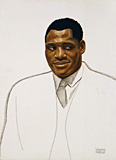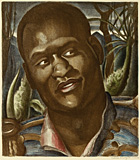
Paul Robeson All-American football player, Phi Beta Kappa graduate of Rutgers University, From his father, Robeson learned that his exceptional talents carried a responsibility to represent his race. Eventually he chose a career as a performer, believing that it provided the greatest opportunities for personal recognition and success as well as a platform for the presentation of African American culture and history. A performer, however, does not have complete control over his public image. With few exceptions, Robeson was unable to escape the stereotypes imposed upon him as an African American actor by the theater and film industries. Most of the characters he played were repetitions of traditional images of black people and not, as Robeson had hoped, roles that advanced the cause of his race.
During the 1930s while Robeson was living and traveling abroad, he came to realize that his responsibilities extended to all peoples subjected to social and political injustice, not only to African Americans.
Paul Bustill Robeson (as Emperor Jones)/ Mabel Dwight/ Lithograph with color, 1930/ National Portrait Gallery, Smithsonian Institution
Curator: Jeffrey C. Stewart, Associate Professor of History and African American Studies, George
Mason University, Fairfax, Va.
Organized by: The Paul Robeson Cultural Center, Rutgers, The State University of New Jersey,
Princeton, N.J.
Traveling Schedule:
May through Sept. 1999: Museum of the City of New York, N.Y.
Catalog: Paul Robeson: Artist and Citizen, edited by Jeffrey C. Stewart. Published by Rutgers
University Press.
Funding for the development of the Rutgers Paul Robeson Centennial Project was provided, in part, by the National Endowment for the Humanities, the Vice President for Academic Affairs and the Provost's Fund of Rutgers University, the William Penn Foundation, the Rockefeller Foundation, the New Jersey State Council on the Arts/Department of State, the American Express Philanthropic Program, Allen and Joan Bildner and the Bildner Family Foundation, the Geraldine R. Dodge Foundation, Sony Music Entertainment, the 1997 Invitational Tennis Tournament of Governor Christine Todd Whitman, and the Louis B. Armstrong Educational Foundation, Inc. |
 and world-renowned actor and singer was one of the twentieth century's most talented Americans.
He was also one of this century's most controversial figures because of his outspoken criticism of American racism and his admiration for Soviet Communism. Although his political advocacy precipitated an intense governmental and public campaign against him, Robeson never deserted his convictions. As an artist and as a citizen he asserted that he had no choice but to champion the cause of oppressed peoples around the world.
and world-renowned actor and singer was one of the twentieth century's most talented Americans.
He was also one of this century's most controversial figures because of his outspoken criticism of American racism and his admiration for Soviet Communism. Although his political advocacy precipitated an intense governmental and public campaign against him, Robeson never deserted his convictions. As an artist and as a citizen he asserted that he had no choice but to champion the cause of oppressed peoples around the world. He also came to understand that he could not rely on the roles written by others to represent his ideas and causes, and so he eventually abandoned acting. As a singer, he found he could control what he performed, and increasingly his concerts became forums for his political and social agenda. By the 1950s, however, his progressive political views fell outside the American mainstream, and he lost the freedom to communicate his ideas. His passport was revoked, auditoriums were closed to him, his words were misquoted by the media, and he was shunned by the black establishment. Robeson eventually regained his passport, when the U.S. Supreme Court ruled that the State Department could not deny citizens the right to travel because of their political beliefs or affiliations. Although Robeson never regained completely his health or career, he became a worldwide symbol of resistance to oppression.
He also came to understand that he could not rely on the roles written by others to represent his ideas and causes, and so he eventually abandoned acting. As a singer, he found he could control what he performed, and increasingly his concerts became forums for his political and social agenda. By the 1950s, however, his progressive political views fell outside the American mainstream, and he lost the freedom to communicate his ideas. His passport was revoked, auditoriums were closed to him, his words were misquoted by the media, and he was shunned by the black establishment. Robeson eventually regained his passport, when the U.S. Supreme Court ruled that the State Department could not deny citizens the right to travel because of their political beliefs or affiliations. Although Robeson never regained completely his health or career, he became a worldwide symbol of resistance to oppression.